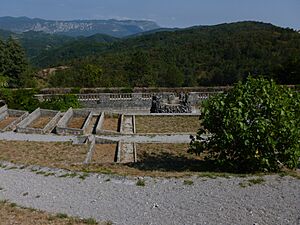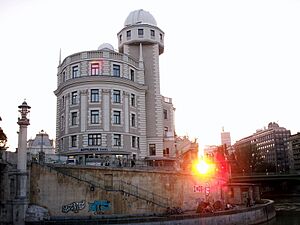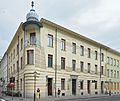Max Fabiani facts for kids
Quick facts for kids
Max Fabiani
|
|
|---|---|
| Born | 29 April 1865 Kobdilj, County of Gorizia and Gradisca, Austrian Empire, today Slovenia
|
| Died | 12 August 1962 (aged 97) Gorizia
|
| Nationality | Italian |
| Alma mater | Vienna College of Technology |
| Occupation | Architect |
| Buildings | Urania palace Palace Portois & Fix |
| Projects | urban development plan for Ljubljana Sacro Cuore metropolitan church, Gorizia |
Maximilian Fabiani, known as Max Fabiani (Italian: Massimo, Slovene: Maks), was an important architect and town planner. He was born on April 29, 1865, in the village of Kobdilj, which is now in Slovenia. He spoke three languages and had both Italian and Austrian family roots.
Max Fabiani, along with Ciril Metod Koch and Ivan Vancaš, helped bring the Vienna Secession style of architecture to Slovenia. This style is a type of Art Nouveau, known for its unique and flowing designs.
Contents
Max Fabiani's Life Story
Fabiani was born into a wealthy family. His father, Antonio Fabiani, was a large landowner from Friuli, Italy. His mother, Charlotte von Kofler, was from a noble family in Trieste.
He grew up speaking Italian, which was his family's language. He also learned Slovene, the language of the people around him, and German when he was very young. This made him a "cosmopolitan" person, meaning he was comfortable with many cultures.
His family had 14 children and could afford to give them a good education. Max went to elementary school in Kobdilj. Later, he attended a German and Slovene-language school called a Realschule in Ljubljana. He was an excellent student there for seven years.
After school, he moved to Vienna to study architecture at the Vienna University of Technology. He finished his degree in 1889. Then, he received money to travel for three years (1892–1894). He visited places like Asia Minor and many parts of Europe.
Max Fabiani was married and had two children. His son, Lorenzo Fabiani, born in 1907, became a writer and worked in farming. Lorenzo was also known for being against the Fascist political movement.
In 1917, Fabiani became a professor at the University of Vienna. In 1919, one of his former students, Ivan Vurnik, offered him a teaching job at the new University of Ljubljana. However, Fabiani decided not to take the job. He left his teaching position in Vienna and moved to Gorizia, which had become part of Italy. This made him an Italian citizen.
On May 15, 1921, Fabiani joined the Italian Fascist movement. This was less than a year after the Slovenian Trieste National Hall, which he had designed, was burned down by Italian Fascists. It is not fully clear why he joined this group or what he did politically in the years that followed. At the same time, his son was put in jail because he was against the Fascist movement.
In late 1935, when he was 70 years old, Fabiani became the mayor (podestà) of his home village, Štanjel. He stayed mayor during World War II. He used his knowledge of German and his connections to convince German soldiers not to destroy the village. However, parts of the village's old walls and castle were still destroyed in fighting between the German army and Slovene resistance fighters. His own house in Kobdilj, which held many important papers, was also burned.
In 1944, Fabiani moved back to Gorizia. He lived there until he passed away on August 12, 1962.
There is a story that young Adolf Hitler once worked briefly in Fabiani's architecture office in Vienna. However, this story is not true and seems to have been made up in 1966.
Max Fabiani's Architectural Work
When Fabiani returned to Vienna, he joined the studio of famous architect Otto Wagner. He worked there until the end of the century. During this time, he focused on designing buildings and also on planning cities. He was also very dedicated to teaching.
Fabiani's first major project was creating a city plan for Ljubljana, the capital of Carniola (now Slovenia). The city had been badly damaged by an earthquake in April 1895. Fabiani won a competition against another architect, Camillo Sitte, and was chosen to be the main city planner for Ljubljana. One reason he was chosen was that Slovene Liberal Nationalists saw him as a Slovene. Another reason was that he knew Ljubljana well and created a very good and modern plan.
With support from Ljubljana's mayor, Ivan Hribar, Fabiani designed several important buildings in the city. These include the L-shaped girls' school in the Mladika Complex, which is now where the Slovenian Foreign Ministry is located.

His work in Ljubljana made him well-known in the Slovene Lands. This led Slovene liberal nationalists in the Austrian Littoral to ask him to design the National Halls in Gorizia (1903) and Trieste (1904).
Fabiani also created the city plan for Bielsko in Poland. In 1902, these two city plans earned him the first honorary doctorate in urban planning from the University of Vienna.
In the 1920s, he helped lead a large project to rebuild villages and historical buildings. These were in areas of the Julian March that had been destroyed during the Battles of the Isonzo in World War I.
Notable Works Designed by Fabiani
Here are some of the most famous works designed by Max Fabiani:
- Vila Schlegel, Opatija
- Palace Portois & Fix (Vienna, 1898)
- Palace Artaria, Kohlmarkt (Vienna, 1900)
- Lyceum, Mladika Palace (Ljubljana, 1907)
- Krisper House (Ljubljana, 1901)
- Bamberg House (Ljubljana, 1906)
- Palace Urania (Vienna, 1902)
- Revenue Office building (Gorizia, 1903)
- National Hall (Trieste, 1904)
- Prešeren Square and the Prešeren Monument (Ljubljana, unveiled in 1905)
- Stabile Palace (Trieste, 1906)
- The urban development plan for Ljubljana (1895)
- Villa Wechsler (Vienna, 1911)
- San Germano church (Brijuni, 1912)
- The plan for the reconstruction of Gorizia (1921)
- The general urban development plan for Venice (1952)
- Restoration of Gorizia duomo (Gorizia, 1919)
- The general urban development plan of Monfalcone, Italy (1919)
- Villa Bigot (Gorizia, 1921)
- Pellegrini's home in Gorizia (1922)
- Felberbaum's home in Gorizia (1925)
- San Giorgio church (Lucinico, 1927)
- Ferrari garden (Štanjel, 1930–40)
- Sacro Cuore metropolitan church (Gorizia, 1934)
- "Tower of memory", a memorial for Italian soldiers who died in World War I (Gorizia, 1937)
- Casa del Fascio (House of Fascism) (Štanjel, 1938)
Awards and Recognition
- He received the Italian Order of Merit for Culture and Art in Rome on September 10, 1951.
Fabiani's Legacy
- In 1984, a street in Vienna, Austria, was named "Fabianistraße" (Fabiani Street) after him.
- Since 2008, the highest award in Slovenia for achievements in urban planning is named after Max Fabiani.
Gallery
See also
 In Spanish: Maks Fabiani para niños
In Spanish: Maks Fabiani para niños















